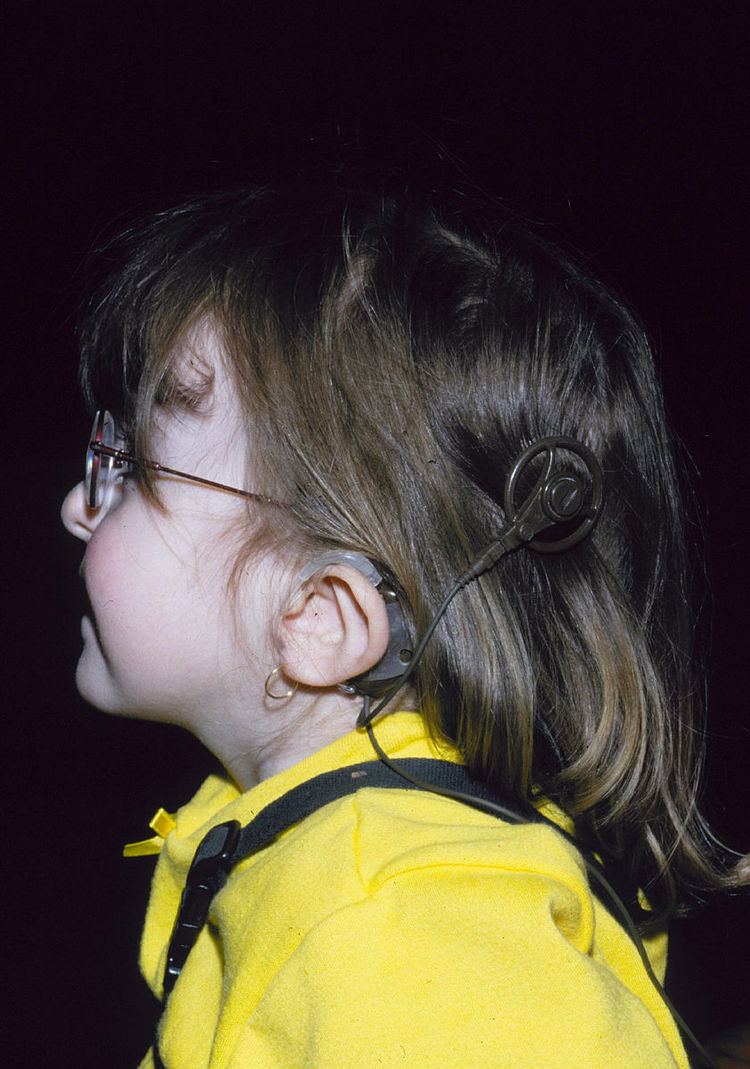Specialty medical genetics ICD-9-CM 759.89 DiseasesDB 32233 | ICD-10 Q87.8 OMIM 214800 eMedicine ped/367 | |
 | ||
CHARGE syndrome (formerly known as CHARGE association), is a rare syndrome caused by a genetic disorder. First described in 1979, the acronym "CHARGE" came into use for newborn children with the congenital features of coloboma of the eye, heart defects, atresia of the nasal choanae, retardation of growth and/or development, genital and/or urinary abnormalities, and ear abnormalities and deafness. These features are no longer used in making a diagnosis of CHARGE syndrome, but the name remains. About two third of cases are due to a CHD7 mutation. CHARGE syndrome occurs only in 0.1–1.2 per 10,000 live births; as of 2009 it was the leading cause of congenital deafblindness in the US.
Contents
History
Dr. B.D. Hall first described the CHARGE association in a 1979 journal paper of about 17 children who had been born with choanal atresia. During the same year, Dr. H.M. Hittner described 10 children who had choanal atresia as well as coloboma, congenital heart defect, and hearing loss. Using both coloboma or choanal atresia and some of the other related characteristic malformations, Dr. R. A. Pagon first coined the acronym CHARGE in 1981 to emphasize that this cluster of associated malformations occurred together. It came to be recognised as a syndrome within the umbrella of the CHARGE association, a set of apparently random signs occurring together. Since the signs seen in CHARGE are caused by a genetic anomaly, its name was eventually changed to 'CHARGE syndrome'.
Genetics
CHARGE syndrome was formerly referred to as CHARGE association, which indicates a non-random pattern of congenital anomalies that occurs together more frequently than one would expect on the basis of chance. Very few people with CHARGE will have 100% of its known features. In 2004, mutations on the CHD7 gene (located on Chromosome 8) were found in 10 of 17 patients in the Netherlands, making CHARGE an official syndrome. A US study of 110 individuals with CHARGE syndrome showed that 60% of those tested had a mutation of the CHD7 gene.
In 2010, a review of 379 clinically diagnosed cases of CHARGE syndrome, in which CHD7 mutation testing was undertaken found that 67% of cases were due to a CHD7 mutation. CHD7 is a member of the chromodomain helicase DNA-binding (CHD) protein family that plays a role in transcription regulation by chromatin remodeling.
Epidemiology
The incidence is estimated to range from 0.1–1.2 per 10,000 live births, though the true incidence is unknown. As of 2005, the highest prevalence was found in Canada and estimated at 1 in 8,500 live births.
Diagnosis
The diagnosis of CHARGE syndrome is often difficult, because it is rare. The syndrome spans many disciplines, and as such, can be diagnosed by a pediatrician, oral and maxillofacial surgeon, ENT specialist, ophthalmologist, audiologist, endocrinologist, cardiologist, urologist, developmental specialist, radiologist, geneticist, physiotherapist, occupational therapist, speech therapist, or orthopedic specialist.
Signs
Although genetic testing positively identifies nearly two thirds of children with CHARGE syndrome, diagnosis is still largely clinical. The following signs were originally identified in children with this syndrome, but are no longer used in to make the diagnosis alone.
Genetic testing
Genetic testing for CHARGE syndrome involves specific genetic testing for the CHD7 gene. This genetic test is not widely available. The test is available at Emory University and the University of Chicago. The test is expensive, currently $2400 at the University of Chicago (plus additional costs charged by the facility or doctor's office drawing the blood). Insurance companies sometimes do not pay for such genetic tests, though this is changing rapidly as genetic testing is becoming standard across all aspects of medicine. For some physicians, the standard of care is to diagnose cases of CHARGE syndrome based on clinical features alone.
Screening other organ systems
Once the diagnosis is made based on clinical signs, it is important to investigate other body systems that may be involved. For example, if the diagnosis is made based on the abnormal appearance of the ears and developmental delay, it is important to check the child's hearing, vision, heart, nose, and urogenital system. Ideally, every child newly diagnosed with CHARGE syndrome should have a complete evaluation by an ENT specialist, audiologist, ophthalmologist, pediatric cardiologist, developmental therapist, and pediatric urologist.
Therapy and outcome
Children with CHARGE syndrome may have a number of life-threatening medical conditions; with advances in medical care, these children can survive and can thrive with the support of a multidisciplinary team of medical professionals. Therapies and education must take into consideration hearing impairment, vision problems, and any others. Early intervention, such as occupational, speech-language, and physical therapy, to improve static posture, ambulation, and self-care skills is important. The intelligence of children with multiple health impairments, such as combined deafblindness, can be underestimated in the absence of early intervention.
Education
Children with CHARGE syndrome will vary greatly in their abilities in the classroom: some may need little support, while some may require full-time support and individualized programs. Taking each of the various affected body systems into account is vital to the success of the child in the educational setting. An important step in dealing with abnormal behavior is understanding why it is occurring and helping the child learn more appropriate methods of communicating. Before a child reaches age 18 (or the age of maturity in their country) doctors and specialists need to be found that will follow the individual in adulthood.
